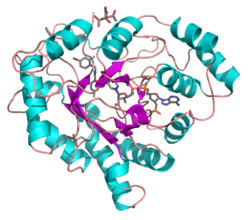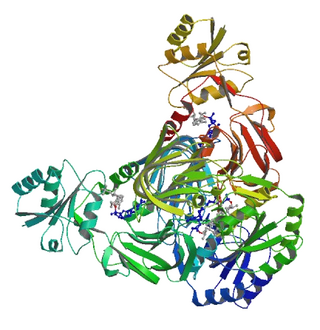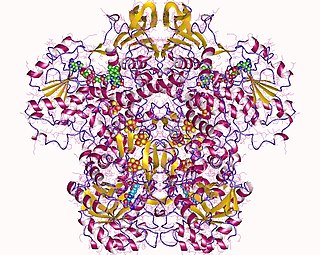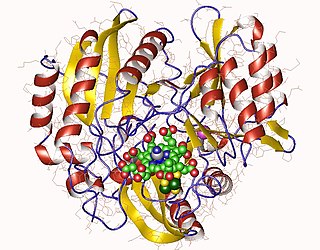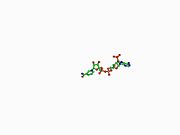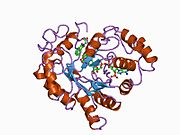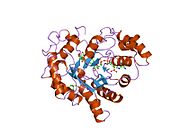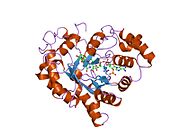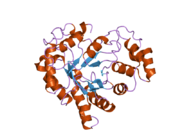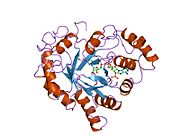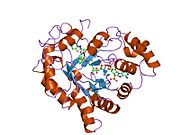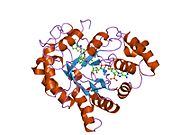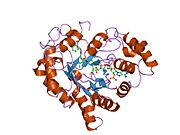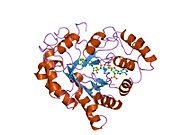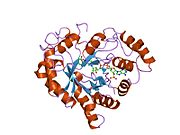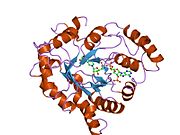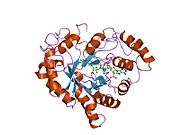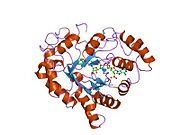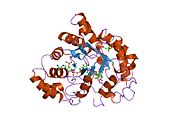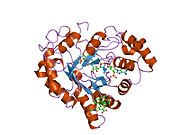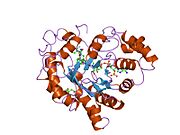1abn: THE CRYSTAL STRUCTURE OF THE ALDOSE REDUCTASE NADPH BINARY COMPLEX
1ads: AN UNLIKELY SUGAR SUBSTRATE SITE IN THE 1.65 ANGSTROMS STRUCTURE OF THE HUMAN ALDOSE REDUCTASE HOLOENZYME IMPLICATED IN DIABETIC COMPLICATIONS
1az1: ALRESTATIN BOUND TO C298A/W219Y MUTANT HUMAN ALDOSE REDUCTASE
1az2: CITRATE BOUND, C298A/W219Y MUTANT HUMAN ALDOSE REDUCTASE
1ef3: FIDARESTAT BOUND TO HUMAN ALDOSE REDUCTASE
1el3: HUMAN ALDOSE REDUCTASE COMPLEXED WITH IDD384 INHIBITOR
1iei: CRYSTAL STRUCTURE OF HUMAN ALDOSE REDUCTASE COMPLEXED WITH THE INHIBITOR ZENARESTAT.
1mar: REFINED 1.8 ANGSTROMS STRUCTURE OF HUMAN ALDOSE REDUCTASE COMPLEXED WITH THE POTENT INHIBITOR ZOPOLRESTAT
1pwl: Crystal structure of human Aldose Reductase complexed with NADP and Minalrestat
1pwm: Crystal structure of human Aldose Reductase complexed with NADP and Fidarestat
1t40: Crystal structure of human aldose reductase complexed with NADP and IDD552 at ph 5
1t41: Crystal structure of human aldose reductase complexed with NADP and IDD552
1us0: HUMAN ALDOSE REDUCTASE IN COMPLEX WITH NADP+ AND THE INHIBITOR IDD594 AT 0.66 ANGSTROM
1x96: Crystal structure of Aldose Reductase with citrates bound in the active site
1x97: Crystal structure of Aldose Reductase complexed with 2R4S (Stereoisomer of Fidarestat, 2S4S)
1x98: Crystal structure of Aldose Reductase complexed with 2S4R (Stereoisomer of Fidarestat, 2S4S)
1xgd: Apo R268A human aldose reductase
1z3n: Human aldose reductase in complex with NADP+ and the inhibitor lidorestat at 1.04 angstrom
1z89: Human Aldose Reductase complexed with novel Sulfonyl-pyridazinone Inhibitor
1z8a: Human Aldose Reductase complexed with novel Sulfonyl-pyridazinone Inhibitor
2acq: AN ANION BINDING SITE IN HUMAN ALDOSE REDUCTASE: MECHANISTIC IMPLICATIONS FOR THE BINDING OF CITRATE, CACODYLATE, AND GLUCOSE-6-PHOSPHATE
2acr: AN ANION BINDING SITE IN HUMAN ALDOSE REDUCTASE: MECHANISTIC IMPLICATIONS FOR THE BINDING OF CITRATE, CACODYLATE, AND GLUCOSE-6-PHOSPHATE
2acs: AN ANION BINDING SITE IN HUMAN ALDOSE REDUCTASE: MECHANISTIC IMPLICATIONS FOR THE BINDING OF CITRATE, CACODYLATE, AND GLUCOSE-6-PHOSPHATE
2acu: TYROSINE-48 IS THE PROTON DONOR AND HISTIDINE-110 DIRECTS SUBSTRATE STEREOCHEMICAL SELECTIVITY IN THE REDUCTION REACTION OF HUMAN ALDOSE REDUCTASE: ENZYME KINETICS AND THE CRYSTAL STRUCTURE OF THE Y48H MUTANT ENZYME
2agt: Aldose Reductase Mutant Leu 300 Pro complexed with Fidarestat
2dux: Crystal structure of human Aldose Reductase complexed with zopolrestat after 3 days soaking (3days_soaked_1)
2duz: Human Aldose Reductase complexed with inhibitor zopolrestat after 3 days soaking (3days_soaked_2)
2dv0: Human Aldose Reductase complexed with zopolrestat after 6 days soaking(6days_soaked_2)
2f2k: Aldose reductase tertiary complex with NADPH and DEG
2fz8: Human Aldose reductase complexed with inhibitor zopolrestat at 1.48 A(1 day soaking).
2fz9: Human Aldose Reductase complexed with inhibitor zopolrestat after six days soaking.
2fzb: Human Aldose Reductase complexed with four tolrestat molecules at 1.5 A resolution.
2fzd: Human aldose reductase complexed with tolrestat at 1.08 A resolution.
2hv5: Human Aldose Reductase complexed with inhibitor zopolrestat after three days soaking (3days_soaked_3)
2hvn: Human Aldose Reductase-zopolrestat complex obtained by cocrystallisation after one day (1day_cocryst)
2hvo: Human Aldose Reductase-zopolrestat complex obtained by cocrystallisation (10days_cocryst)
2i16: Human aldose reductase in complex with NADP+ and the inhibitor IDD594 at temperature of 15K
2i17: Human aldose reductase in complex with NADP+ and the inhibitor IDD594 at temperature of 60K
2ikg: Aldose reductase complexed with nitrophenyl-oxadiazol type inhibitor at 1.43 A
2ikh: Human aldose reductase complexed with nitrofuryl-oxadiazol inhibitor at 1.55 A
2iki: Human aldose reductase complexed with halogenated IDD-type inhibitor
2ikj: Human aldose reductase complexed with nitro-substituted IDD-type inhibitor
2ine: Crystal Structure of Aldose Reductase complexed with Phenylacetic Acid
2inz: Crystal Structure of Aldose Reductase complexed with 2-Hydroxyphenylacetic Acid
2ipw: Crystal Structure of C298A W219Y Aldose Reductase complexed with Dichlorophenylacetic acid
2iq0: Crystal Structure of Aldose Reductase complexed with Hexanoic Acid
2iqd: Crystal Structure of Aldose Reductase complexed with Lipoic Acid
2is7: Crystal Structure of Aldose Reductase complexed with Dichlorophenylacetic acid
2isf: Crystal Structure of C298A W219Y Aldose Reductase complexed with Phenylacetic Acid
2j8t: HUMAN ALDOSE REDUCTASE IN COMPLEX WITH NADP AND CITRATE AT 0.82 ANGSTROM
2nvc: Human Aldose Reductase complexed with novel naphtho[1,2-d]isothiazole acetic acid derivative (3)
2nvd: Human Aldose Reductase complexed with novel naphtho[1,2-d]isothiazole acetic acid derivative (2)
2pev: Complex of Aldose Reductase with NADP+ and simultaneously bound competitive inhibitors Fidarestat and IDD594. Concentration of Fidarestat in soaking solution exceeds concentration of IDD594.
2pf8: Complex of Aldose Reductase with NADP+ and simultaneously bound competitive inhibitors Fidarestat and IDD594. Concentration of Fidarestat in soaking solution is equal to concentration of IDD594.
2pfh: Complex of Aldose Reductase with NADP+ and simultaneously bound competitive inhibitors Fidarestat and IDD594. Concentration of Fidarestat in soaking solution is less than concentration of IDD594.
